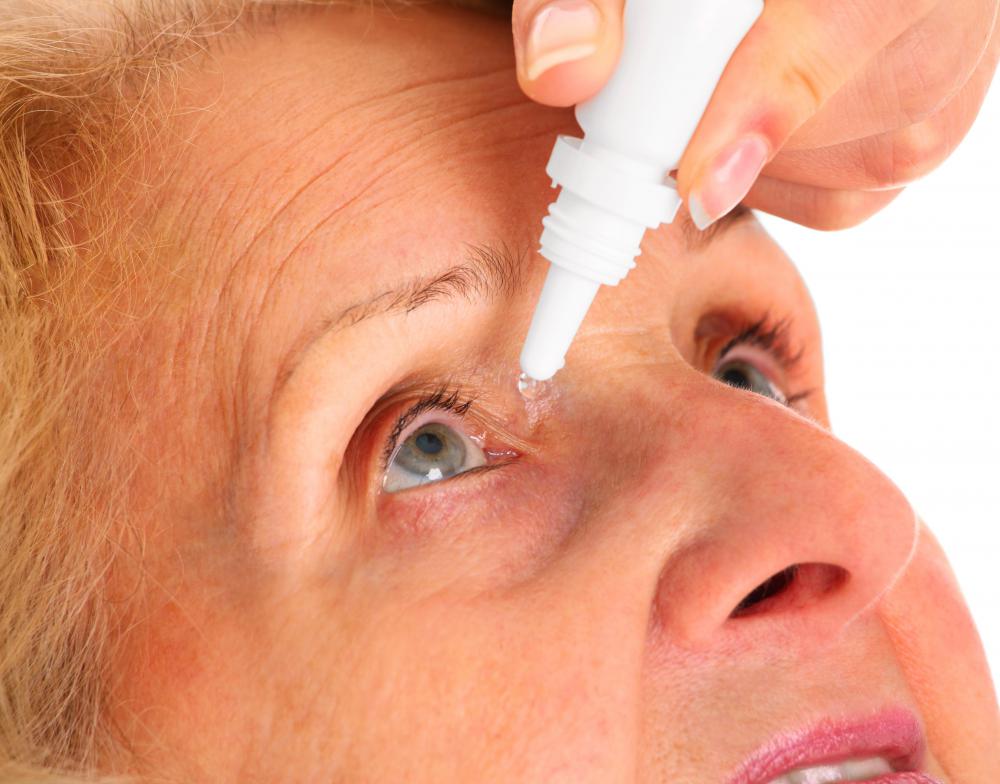At TheHealthBoard, we're committed to delivering accurate, trustworthy information. Our expert-authored content is rigorously fact-checked and sourced from credible authorities. Discover how we uphold the highest standards in providing you with reliable knowledge.
What is Hydroxypropyl Methyl Cellulose?
Hydroxypropyl methyl cellulose (HPMC) is a polymer used for multiple applications in fields such as construction and ophthalmology. It is also known as hypromellose, which is the international, non-proprietary name (INN) for this substance. The name is not patented by any drug company, and can be used without fear of trademark or copyright infringement. HPMC is a solid substance at room temperature and is typically beige in color.
One of the most important properties of hydroxypropyl methyl cellulose is that, in a water-based solution, it does not have a gelation property when heated. Instead of precipitating out as methylcellulose does, it causes the entire solution to congeal into a semi-flexible mass that can no longer flow. The more HPMC that is present, the lower the critical temperature needed to achieve this effect.

The ability of hydroxypropyl methyl cellulose to absorb water is what has led to one of its most common uses — as a substitute for human eye tear-film. When this substance is added to eye drops or other ophthalmologic aids, it increases the amount of time the drops spend on the cornea by absorbing the water that is present and preventing early evaporation. Theoretically, the longer a lubricant substance stays on an eye, the less irritation suffered. Solutions containing 2% hydroxypropyl methyl cellulose are typically used during orbital surgery to protect the corneas.

In addition to being used as a ocular protector, hypromellose is also used in the construction industry to make adhesives, and to mitigate the presence of water. The leading manufacturer of HMPC for industrial applications is Dow Wolff Cellulosics GmbH, and one of their most popular products is Walocel™ which is a thickening agent. When used in a construction environment, the function of HPMC is very similar to hydroxy ethyl methyl cellulose (HEMC).
This compound is also used as a food additive for thickening and emulsifying liquids. It is recognized in the Codex Alimentarius, which is Latin for food book — an internationally recognized set of guidelines which pertain to food safety and use. Hydroxypropyl methyl cellulose also carries code E464 in the European Union, making it a known and listed food additive.
HPMC is a semi-synthetic compound that is non-toxic to humans. It must be treated carefully, however, as it does react strongly if exposed to oxidizing agents. It is also combustible. This compound is listed by the Chemical Abstracts Service (CAS) as number 9004-65-3. These numbers are assigned to chemicals in order to help chemists locate them in searchable databases.
AS FEATURED ON:
AS FEATURED ON:












Discussion Comments
@anon135045: Flour isn't just combustible. It's literally explosive. Yet if you are an average citizen of this side of the planet, you eat bread every day.
So is Hydroxypropyl methyl cellulose an alcohol or is it composed of an alcohol? -- BlackMarker
@Anon151874: The cellulose can be derived from any plant but typically comes from cotton linters or wood fiber. It is then swelled with alkalis and reacted to form the cellulose ether.
@Anon173857: See above, and yes it really is non-toxic. It's also non-digestible and can actually aid in digestion/bowel regulation similar to what is generally referred to as "dietary fiber."
In response to anon135045, several examples of how something flammable is safe for human consumption have already been given, but in the case of HPMC, most of its flammable properties come as a result of the raw material being a very fine powder. Both flour and dehydrated milk/creamer are flammable to the point of being considered explosive when dispersed in air, and both of those things would typically be considered food.
In response to your complaints regarding "chemicals made in a lab," I agree that there are certain things that should not be consumed and are of concern, such as certain solvents and pesticides used, but to generalize to all things made in lab is simply ignorant.
Many additives such as vitamins and antioxidants are beneficial for you and preservatives may have potential to be harmful, but they greatly reduce the risk of consumers being exposed to much worse bacterial or fungal exposure. As to your final statement of "Agenda 21 is in full swing" what are you implying and how does that relate to this post? I haven't read the full 300-plus page document, but I don't see the relevance here in my limited understanding of it.
It's in vitamin tablets.
@anon135045: Please conduct some research on your own, if you are that interested, as the other users of this website might not have enough time to answer your many, many questions.
you see alcohol is very combustible.
what is this substance is extracted from? And this substance really is non-toxic?
what plant is the actual source of this? wood? corn? what?
How is something combustible safe for human consumption?
Well, corn burns pretty well. You can use it in place of wood pellets in pellet stoves. I don't think that's a useful test for consumability.
so this ingredient is in a product for cracked skin? how does that work - does it glue the cracks together with no healing property?
How is something combustible safe for human consumption?
The Codex Alimentarius is nothing short of false in many of its recognitions. Food is food and chemicals made in a lab should never have been considered safe as food or food additives.
In fact, many of its assertions are proven harmful to humans and in no way are foods by definition.
Research it, much of it is craziness. Agenda 21 is in full swing.
Post your comments